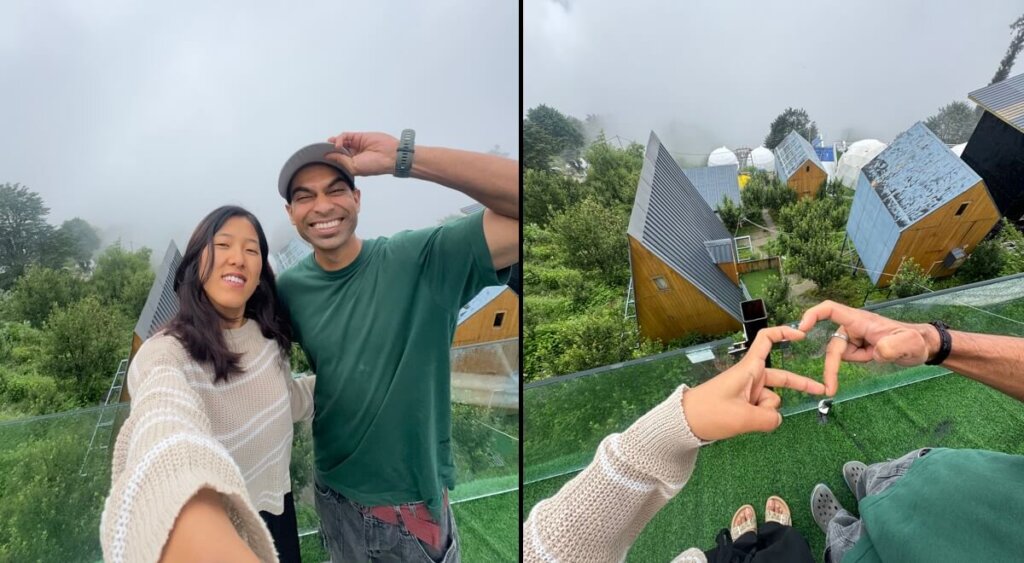Manali, the jewel of Himachal Pradesh, is a year-round destination that draws tourists with its snow-capped peaks, lush valleys, and adventurous spirit. However, the question that looms large for many travelers is: “Is it safe to travel to Manali during monsoon?” The answer, like the mountains themselves, is not a simple yes or no. It’s a nuanced exploration of risks and rewards, preparation and spontaneity.
I mean there is no direct danger involved because think of it this way: Local families, including, kids, elderly, and everyone else in between live here. They do not escape to Delhi or Bangalore or someplace else during monsoon. And they survive. Meaning, there is no direct danger. It’s just that road transportation can sometimes be (and that too at some place, not across state at once) a little dangerous because of sliding parts of land.
So yea, this comprehensive article will dive deep into the realities of monsoon travel in Manali, providing you with all the information you need to make an informed decision and, if you choose to go, to have a safe and unforgettable experience.
The Appeal of Manali in Monsoon
Before we get to the potential risks, let’s talk about why anyone would even consider visiting Manali during the rainy season. The monsoon months, from July to September, paint a completely different picture of the town.
- Lush, Vibrant Greenery: The rain breathes life into the landscape, transforming the brown hills into a canvas of a hundred shades of green. The air is fresh, clean, and filled with the earthy scent of wet soil.
- Gushing Waterfalls and Rivers: The streams and waterfalls that are a mere trickle in the summer come alive with a ferocious beauty. The Beas River, in particular, flows with a powerful, mesmerizing energy.
- Misty Mountains and Serene Vistas: The misty mornings and fog-covered mountains create a surreal, ethereal atmosphere. This is the time for photographers and romantics to truly appreciate Manali’s unadulterated beauty.
- Fewer Crowds and Better Deals: As this is considered the off-season, you’ll find fewer tourists and can enjoy the tranquility of the town. Accommodation prices are often significantly lower, making it a budget-friendly option.
Check this video from my 20-day monsoon ride in Himachal and you will how beautiful it can be…
But then, sometimes excess rain can wreck havoc. For example the floods of 2025 monsoon brought devastation across Manali. Check the Youtube video below…
So yea, check weather and current road updates before you plan a trip to Manali in monsoon. And it’s not just Manali, it’s all destinations across mountains.
For a traveler who seeks a peaceful retreat, loves the rain, and isn’t solely focused on adventure sports, a monsoon trip to Manali can be a truly rewarding and intimate experience with nature.
The Unavoidable Risks: A Reality Check
Now, for the honest and crucial part. The monsoon in Manali comes with a set of significant challenges and risks that cannot be ignored. The recent years, including events in 2023 and 2024, have highlighted the increased vulnerability of the region to heavy rains.
1. Landslides and Roadblocks
This is the biggest and most serious risk of monsoon travel in the Himalayan region. Heavy rainfall destabilizes the mountainous terrain, leading to frequent landslides and rockfalls.
- Chandigarh-Manali Highway: The primary road connecting Manali to the rest of the country is particularly prone to blockages. Stretches of this highway, especially between Mandi and Manali, have been known to get washed away or become impassable for days, sometimes even weeks.
- Being Stranded: There is a real possibility of your travel plans being severely disrupted. You could be stuck on the highway for hours or even be marooned in your hotel room for a couple of days if local roads are also blocked.
- Recent Events: Reports from recent years have shown extensive damage, with roads being torn apart, tunnels flooding, and thousands of tourists being stranded. Unscientific road-cutting for infrastructure projects has been cited by some experts as a contributing factor to the increased number of landslides.
2. Flash Floods and Cloudbursts
Manali and its surrounding areas are susceptible to flash floods, which can occur suddenly and with devastating force.The Beas River, while beautiful, can turn into a raging torrent. It is extremely dangerous to venture near the riverbanks during this season. Cloudbursts, a localized, intense rain event, can trigger these flash floods and landslides in a matter of minutes.
3. Limited Adventure Activities
If your primary goal is to indulge in adventure sports, the monsoon might disappoint you. Most adventure activities like river rafting, paragliding, and certain high-altitude treks are often suspended by the local administration for safety reasons. The trails become slippery and dangerous for trekking.
4. Disrupted Services
Monsoon can lead to power cuts and disruptions in water supply and mobile network connectivity. It is a good idea to be prepared for these inconveniences.
Is It Safe to travel Manali during monsoon? The Final Verdict
So, is it safe? The general consensus among travel experts and locals is that traveling to Manali during the peak monsoon months of July and August is not advisable, especially for first-time visitors or those on a tight schedule. The unpredictability of the weather and the high risk of landslides and floods make the journey fraught with uncertainty.
However, for a seasoned traveler with a flexible itinerary and a love for the rains, a monsoon trip can be managed with extreme caution and preparation.
Essential Safety Tips for a Monsoon Trip to Manali
If you decide to take the leap, here are a few critical tips to ensure your safety:
1. Plan Your Travel Carefully
- Monitor the Weather Forecast: Check the weather forecast and road conditions right up until the day of your travel. Websites, local news, and social media pages of the Himachal Pradesh police or tourism department can be excellent sources.
- Flexible Itinerary: Do not book a trip with a rigid schedule. Keep a few extra days in your plan in case of roadblocks or delays.
- Choose Your Transport Wisely: Traveling by car with an experienced local driver is often a safer bet than a self-driven vehicle. Local drivers are familiar with the terrain and the signs of impending trouble. Volvos or large buses are generally safer than smaller cars.
2. Pack the Right Gear
- Waterproof Everything: Your most important items are a good quality waterproof jacket, waterproof shoes, and a waterproof cover for your backpack.
- Layered Clothing: The temperatures can fluctuate. Pack quick-drying, layered clothing.
- Essentials Kit: Carry a small first-aid kit with basic medicines for fever, cold, and stomach upsets. A flashlight and a power bank are non-negotiable, as power cuts are common.
3. In Manali: Stay Safe and Informed
- Stay in Well-Connected Areas: Choose a hotel or homestay in a central, well-connected part of Manali. Avoid staying in remote areas or too close to the river.
- Avoid Risky Activities: Do not venture near the Beas River or any other water bodies. Avoid trekking or hiking in remote or unfamiliar areas.
- Follow Local Advice: Listen to the locals. If they advise against a particular route or activity, heed their warning.
- Emergency Contacts: Keep a list of emergency contacts, including local police, hotel staff, and family members.
The Best Time to Visit Manali (If Not Monsoon)
For those who want to avoid the risks and enjoy a more typical Himalayan experience, the shoulder seasons are ideal.
- March to June (Summer): This is the peak tourist season with pleasant weather, blooming flowers, and a full range of activities like paragliding, rafting, and trekking.
- September to October (Post-Monsoon): This is a beautiful time to visit. The monsoon has just ended, leaving the landscape clean and green. The weather is crisp and clear, perfect for sightseeing and enjoying outdoor activities.
- December to February (Winter): If you’re a snow lover, this is the time to go. Manali transforms into a winter wonderland with snow-covered mountains and opportunities for skiing and other snow sports.
Also read: Best Cafes to eat and Things to do in Manali
Conclusion: Weighing the Risks and Rewards
Traveling to Manali during monsoon is a high-risk, high-reward proposition. On one hand, you get to witness an unparalleled natural beauty that few get to see. The misty mountains, raging rivers, and lush greenery create a poetic and introspective travel experience. On the other hand, you face serious risks of being stranded due to landslides and flash floods, with all the accompanying inconveniences.
Ultimately, the decision is yours. If you are an adventurous soul with a flexible schedule, the right mindset, and a commitment to safety, a monsoon trip to Manali can be a breathtaking journey. For most travelers, however, it is prudent to choose a safer, more predictable time of the year to experience the magic of this Himalayan paradise.

